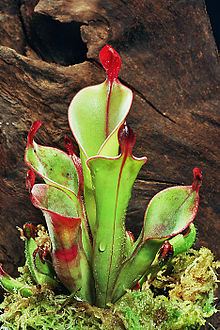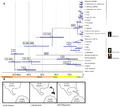Sarraceniaceae
| Sarraceniaceae Temporal range: Early Cretaceous – recent
| |
|---|---|

| |
| Heliamphora chimantensis | |
| Scientific classification | |
| Kingdom: | |
| (unranked): | |
| (unranked): | |
| (unranked): | |
| Order: | |
| Family: | Sarraceniaceae |
| Genera | |
The Sarraceniaceae are a family of pitcher plants, belonging to order Ericales (previously Nepenthales).
The family comprises three extant genera: Sarracenia (North American pitcher plants), Darlingtonia (the cobra lily or California pitcher plant), and Heliamphora (sun pitchers).[1][2] The extinct Archaeamphora longicervia may also belong to this family.[3] The first two are native to North America while Heliamphora is native to South America. All three are carnivorous plants that lure insects with nectar and use their elongated, tube-shaped leaves filled with water and digestive enzymes (or bacteria in the case of Darlingtonia) to catch and consume them. Many species also use downward-pointing hairs and waxy secretions to make it difficult for insects to escape.
These plants grow in nutrient-poor, often acidic soil and use the insects as a nutritional supplement. The pitchers originate from a rhizome and die back during the winter dormancy. Plants of the genus Sarracenia occur mostly in Sphagnum bogs.
Most Sarraceniaceae have tall, narrow pitchers that are vertical or nearly so. Sarracenia purpurea, however, has short, squat, bulbous pitchers close to the ground, and Sarracenia psittacina has pitchers that grow horizontally.
The purple pitcher plant (Sarracenia purpurea) is the official flower of Newfoundland and Labrador.
-
Archaeamphora longicervia, extinct
-
Sarraceniaceae chronogram based on combined data
References
- ^ McPherson, S. & D. Schnell 2011. Sarraceniaceae of North America. Redfern Natural History Productions Ltd., Poole.
- ^ McPherson, S., A. Wistuba, A. Fleischmann & J. Nerz 2011. Sarraceniaceae of South America. Redfern Natural History Productions Ltd., Poole.
- ^ Li, H. 2005. Template:PDFlink Acta Bot. Gallica 152(2): 227-234.
- ^ Ellison, A.M., E.D. Butler, E.J. Hicks, R.F.C. Naczi, P.J. Calie, C.D. Bell & C.C. Davis 2012. Phylogeny and biogeography of the carnivorous plant family Sarraceniaceae. PLoS ONE 7(6): e39291. doi:10.1371/journal.pone.0039291
- Sarraceniaceae in L. Watson and M.J. Dallwitz (1992 onwards). The families of flowering plants.
- D’Amato, Peter, The Savage Garden: Cultivating Carnivorous Plants, Berkeley 1998, ISBN 0-89815-915-6





![Combined nuclear, plastid and mitochondrial phylogeny of Sarraceniaceae[4]](http://upload.wikimedia.org/wikipedia/commons/thumb/e/ed/Sarraceniaceae_combined_maximum_likelihood_phylogeny.png/120px-Sarraceniaceae_combined_maximum_likelihood_phylogeny.png)
